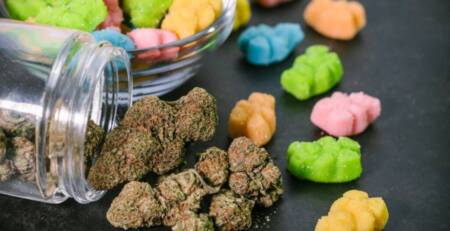Cannabis Oil Distillate: What is it Exactly?
How would you like your cannabis?
Back in the day, marijuana was just a crumbly flower that you rolled up in a joint and smoked. Now, you can get a variety of cannabis concentrates that enhance your ingestion experience. These concentrates aren’t green – they might look pretty unappetizing when you’re just introduced to them. But they have a spectacular amount of THC (we’re talking 99% THC) to give you a powerful high with just a little bit of substance.
In this post, we’re going to review cannabis oil distillates, one of the hottest new concentrates to experiment with. What is it? How is it made? And how can you use distillates to enhance your experience?
Let’s get started.
How Distillates Are Made
Distillate is pretty closely linked to another word: distillation. If you enjoy hard alcohol, you’ve probably heard this word before. Vodka, whisky, and gin are just a few type of alcohol beverages that go through a distillation process. Wine and beer are not distilled.
Like alcohol, the cannabis that goes through a distillation process is stronger and more concentrated that cannabis that doesn’t. This process isolates specific chemical compounds until you have an almost pure substance left. The distillates you buy are up to 99% THC.
That’s a lot of THC.

How Does Distillation Work?
First things first.
Just like alcohol, cannabis must go through a number of processes before the actual distillation. Alcohol has to be fermented; otherwise, you won’t get drunk. Cannabis has to be decarbed; otherwise, you won’t get high. And before the decarboxylation process occurs, individual compounds need to be extracted first.
The distillation process is a purification process of the compounds that are left. Here’s a basic rundown of this process.
Chemical compounds have different weights and boiling points. Some compounds will evaporate in higher temperatures, leaving heavier compounds at the bottom. The lighter compounds are then transported to a different part of the distillation process, cooled, and extracted.
That’s the basic rundown, and it may be conducted a few times to purify the cannabis and extract THC or CBD.
Different Distillation Methods
The truth is, not all cannabis cannabinoids are distilled through the same process. There are a few different methods of distillation that can be used to produce a product that is 99% THC.
Most of these methods didn’t start with cannabis. Steam distillation, for example, was a big trend in creating essential oils. Steam distillation uses – you guessed it, steam – to transport certain compounds through this process. Once the compounds condense, they are exposed to lower temperatures and don’t have to face the risk of breaking down.
Essential oil producers have since moved to vacuum distillation. Short path distillation and fractional distillation are also popular methods of producing distillates that go onto the market.

What Is Left?
The substance that comes out of the distillation process (and the substance that you’ll buy online) looks nothing like the bud that it came from. It’s an oily substance free of smell and taste. All of the terpenes are removed through the distillation process, so there is no flavour left in your distillate.
Distillate vs. Isolate
Some manufacturers have begun to add terpenes for aroma and taste, but if you want a pure distillate, you won’t be able to enjoy the dank smells of bud. This is the difference between “distillate” and “isolate.” Isolates won’t contain additional terpenes or flavours; they are pure and raw THC or CBD. Distillates, while they can be 99% THC or CBD, might have some additional compounds that reduce the concentration to 80% or so.
Do your research before you buy. How much THC are you getting in your product? What has been added?
Can I Distill Cannabis At Home?
It is possible to produce your own distillates, but you’ll need to buy an apparatus that conducts short path distillation. (Short path is the best path to go because the path is literally short and you don’t need a lot of space in your house for the apparatus.)
The apparatus will cost you a few thousand dollars. It’s certainly an investment, so we recommend buying a few distillates and trying them out before you start to take production into your own hands. You can’t just shove your bud into the system and expect to get distillates, so do your research before you buy.
How to Use Distillates
One of the benefits of having distillate handy is that you can integrate it into any method of consumption that you prefer. Whether you prefer smoking vs. edibles, dabbing or other methods, you can use distillates.
Drop It
Distillates are ready for consumption; a little drop under your tongue will do!
Eat It
You can also drop your distillate into a tea or blended drink to consume it. Remember, without additional terpenes, your distillate will be flavourless. Many cannabis consumers are choosing to infuse their distillates into butter or add them to edibles to get a great high without the icky pot flavour that you might be used to.
Smoke It
You can even smoke your distillate! Drop a tiny bit into a joint or a blunt alongside tobacco or bud.

Vape It
One of the most popular ways to consume distillates is to put them in a vape cartridge. Add the distillate to an empty cartridge and vape away!
(How do distillates compare to other types of concentrates in vapes? We’ll break it down for you.)
Dab It
You will need to keep your distillate cool and solid if you want to add a bit to your dab rig. Remember, the concentrate is up to 99% THC; if you’re new to dabbing, be careful and take it easy.
Mix It
Once of the benefits of having a pure, isolated chemical compound is that it can be mixed with other compounds. Scientists are still working on ways to mix distillates with other compounds for medicinal purposes. In the future, distillates may be a key component of revolutionary advances in medicine.
Take things easy your first time, but enjoy experimenting with this pure form of the cannabinoids you know and love!











